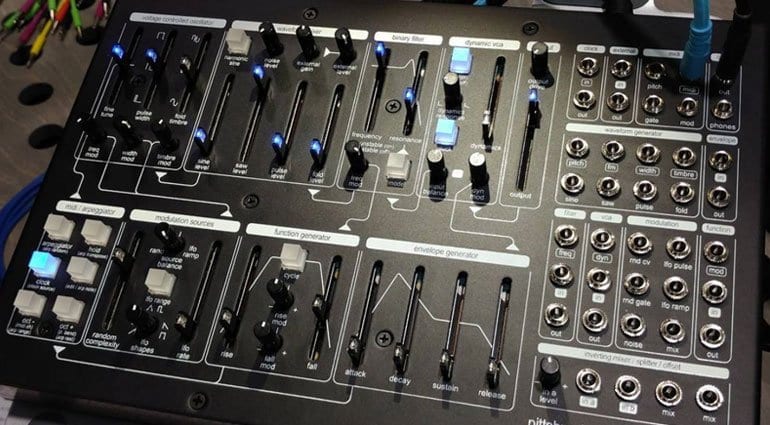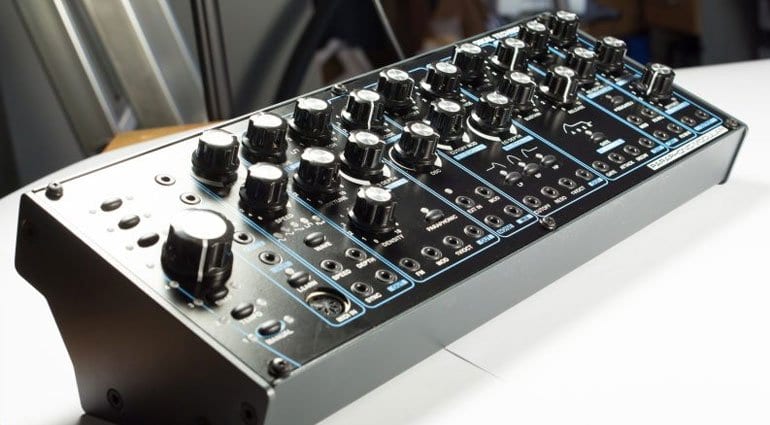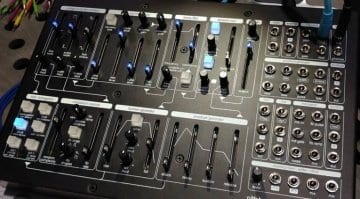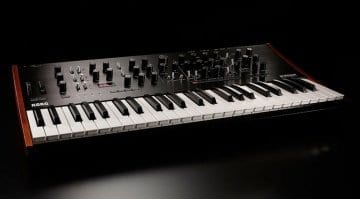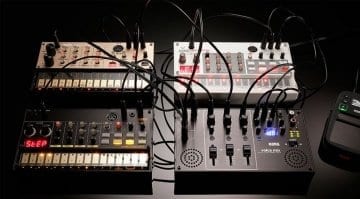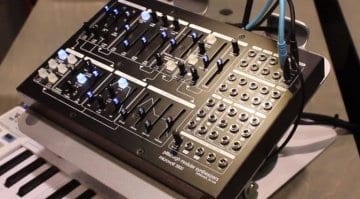Robin’s Top 3 synthesizers from NAMM 2018
NAMM 2018 was a good show for synthesizers. New, shiny, bleeping, flashing, wooden-cheeked hardware is everywhere. From the calm seriousness of the Korg Prologue to Arturia’s triple whammy assault on Eurorack – while somehow not releasing a single module. We witnessed the prevalence of oscillators built on the CEM 3340 and how everything just has to be CV/Gate. These are golden times for the synth enthusiast and there’s no sign of it slowing down.
But if I was to choose three, just three synthesizers that pulled my strings, rang my bells and twiddled my erm… potentiometers then these are the ones that appealed to me.
Pittsburgh Microvolt 3900
What a cute little synth! It’s a little thing but packed with enough quirk to raise the eyebrows of even the most jaded synth head. The black colouring is alluringly sedate, the blue LED sliders lifting moments of joy up from the front panel and you are offered something familiar and yet alternative. There are a lot of analogue monosynths about at the moment, but what the Microvolt does is give you unexpected tools to play with. Firstly a simple bit of wavefolding brings instant harmonic satisfaction. The VCA also offers a low-pass gate mode to introduce some west-coast pluck and twang. And then next to a self-cycling function generator we find a dual LFO with sample & hold.
In Pittsburgh’s modular world these things are unremarkable, but on a monosynth you don’t tend to find these sorts of touches. It doesn’t make the Microvolt 3900 outrageous or “out-there” it simply makes it more interesting and playful than many of the other monosynths on offer. It has all the patch points you need to integrate into a larger modular setup, or if you are looking for an introduction to modular that brings a different flavour of spice to your sound, then check this one out.
More information
- Pittsburgh Modular Microvolt 3900 article.
Radikal Technologies Delta CEP A
This is a big chunk of a synthesizer voice for Eurorack that will also be available as a stand-alone desktop unit – which is why I’m allowed to include it here. The design, for me, is perfectly laid out. Each module clearly defined with its own space and own patch points. I’m not fond of this trend of putting all the patch points in a matrix on the right – you can’t see at a glance where things are routing to. The Delta CEP A sprinkles the patch points exactly where they should be so you always know what’s going on.
Ergonomics are all very well but what does it do? Well, here is where it gets interesting. First of all, you don’t have an oscillator, you have a swarm of oscillators. It can generate up to 8 oscillators to create clusters, clouds, chords and chaos. It’s paraphonic so all that interstellar goodness runs through the single signal chain of the following modules. These chains can be stored as patch memories over in the Interpolator on the left. Patches can then be recalled or morphed and blended between. The LFO is well equipped with 5 waveforms. You can mix noise and external sources in with the oscillators. The filter has one analogue and one digital to play with.
The Delta CEP A is both familiar and regular as a synthesizer voice while harbouring an enormous amount of sonic power. For me it’s too big for Eurorack but would look awesome in a desktop case.
More information
- Radikal Technologies Delta CEP A article.
Korg Prologue
It just has to be the Korg Prologue. It’s the most natural evolution of what Korg have been doing over the last few years. Of the big three Japanese synthesizer manufacturers of Korg, Yamaha and Roland, Korg seem to be the ones who really get it. The mini MS-20, then the ARP reissue, the Volcas and then the Minilogue and Monologue all led up to this point. The Prologue is a proper, grown-up synthesizer. Available with 8 or 16 voices in a design that alludes to many other modern classics amongst which Korg has earned the right to stand.
It’s the sort of synthesizer that would always be a joy to play. Clearly laid out with a fluid workflow. The sound of that analogue signal path combined with some newly engineered Korg magic gives it an uncommon flexibility. Alongside the usual synthesizer stuff is a “multi-engine” oscillator adding digital waveforms, Variable Phase Modulation, noise or something else entirely. And that something else could be provided by any user because the multi-engine is an open format that can be developed for by anyone. This offers a level of access not normally found in synthesizers from large manufacturers.
But overall, as an instrument, I believe the Prologue offers something a bit special. It combines the look, the feel, the sound with an openness that bodes very well for the future of Korg synthesis. I’d very much like one please.
More information
- Korg Prologue article.
So, there you are, my top three, all for different reasons. What do you think of my choices? What really caught your imagination at NAMM 2018. Let me know in the comments below.

